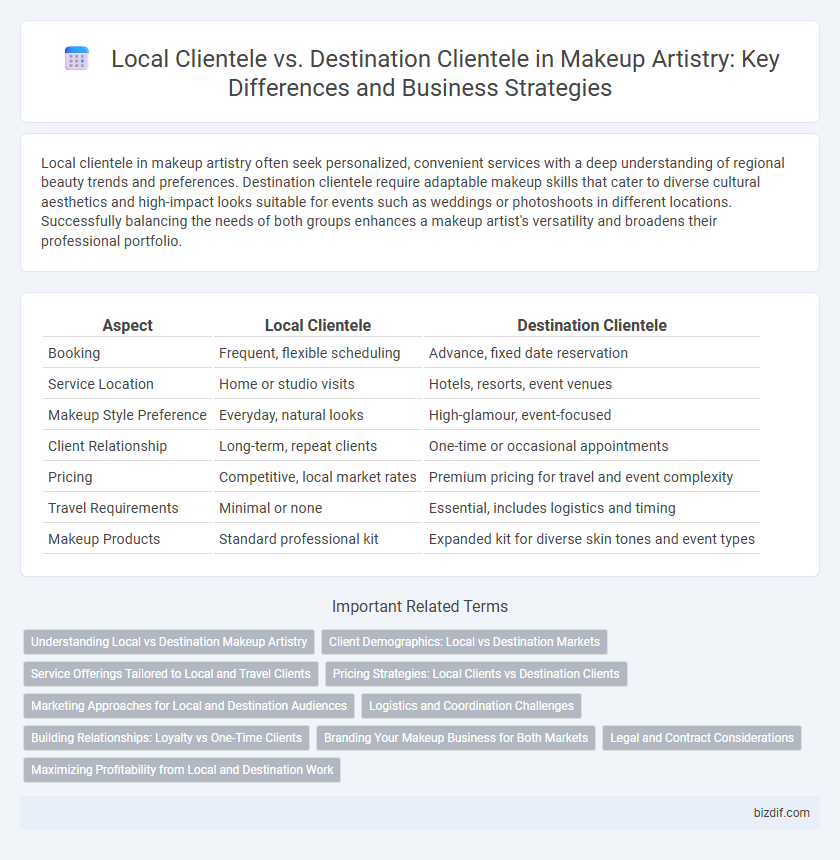Local clientele in makeup artistry often seek personalized, convenient services with a deep understanding of regional beauty trends and preferences. Destination clientele require adaptable makeup skills that cater to diverse cultural aesthetics and high-impact looks suitable for events such as weddings or photoshoots in different locations. Successfully balancing the needs of both groups enhances a makeup artist's versatility and broadens their professional portfolio.
Table of Comparison
| Aspect | Local Clientele | Destination Clientele |
|---|---|---|
| Booking | Frequent, flexible scheduling | Advance, fixed date reservation |
| Service Location | Home or studio visits | Hotels, resorts, event venues |
| Makeup Style Preference | Everyday, natural looks | High-glamour, event-focused |
| Client Relationship | Long-term, repeat clients | One-time or occasional appointments |
| Pricing | Competitive, local market rates | Premium pricing for travel and event complexity |
| Travel Requirements | Minimal or none | Essential, includes logistics and timing |
| Makeup Products | Standard professional kit | Expanded kit for diverse skin tones and event types |
Understanding Local vs Destination Makeup Artistry
Understanding local versus destination makeup artistry involves recognizing the distinct preferences and logistical considerations that impact client expectations and service delivery. Local clientele often seek convenience, personalized consultations, and products suited to everyday wear or regional trends, while destination clients prioritize long-lasting, photo-ready looks that withstand travel conditions and diverse climates. Tailoring techniques and product choices based on these factors enhances client satisfaction and reinforces the makeup artist's adaptability to varied client needs.
Client Demographics: Local vs Destination Markets
Local clientele often consists of repeat customers living within a 30-mile radius, typically seeking convenient makeup services for daily wear or regional events. Destination clientele usually includes brides, models, or celebrities traveling specifically for high-end or specialized makeup artistry, representing a broader geographic and cultural demographic. Understanding these distinct client demographics allows makeup artists to tailor marketing strategies and service offerings effectively for regional loyalty or exclusive, high-profile engagements.
Service Offerings Tailored to Local and Travel Clients
Makeup artists customize service offerings by providing quick touch-ups and regular beauty routines for local clientele, while destination clients receive comprehensive bridal packages and travel-ready makeup kits. Local clients benefit from personalized consultations and easy appointment scheduling, ensuring consistent and convenient service. Destination services emphasize portability, long-lasting products, and adaptability to diverse settings to meet the unique needs of clients traveling for special events.
Pricing Strategies: Local Clients vs Destination Clients
Pricing strategies for makeup artistry differ significantly between local and destination clientele due to varying factors such as travel costs, time investment, and service exclusivity. Local clients often benefit from competitive, tiered pricing structures based on service packages and repeat bookings, while destination clients typically face premium pricing reflecting additional expenses like travel fees, accommodations, and the tailored, high-demand nature of on-location services. Effective segmentation ensures maximized revenue by aligning cost structures with client expectations, geographic considerations, and service customization within the makeup artistry industry.
Marketing Approaches for Local and Destination Audiences
Marketing approaches for makeup artistry differ significantly between local and destination clientele, with local strategies emphasizing community engagement, frequent promotions, and partnerships with nearby salons and event planners to build long-term relationships. For destination clientele, focus shifts to online visibility through targeted social media campaigns, collaborations with travel agencies, and showcasing a portfolio that appeals to out-of-town clients seeking specialized or luxury services. Leveraging geo-targeted ads and personalized booking experiences enhances connection and conversion rates for each audience segment.
Logistics and Coordination Challenges
Local clientele offers streamlined logistics with flexible scheduling and minimal travel time, allowing makeup artists to manage appointments and product inventory efficiently. Destination clientele presents complex coordination challenges, including travel arrangements, varying lighting conditions, and communication across time zones, requiring meticulous planning and adaptability. Balancing these demands, makeup artists must optimize resource allocation and maintain strong client communication to ensure seamless service delivery.
Building Relationships: Loyalty vs One-Time Clients
Building strong relationships with local clientele fosters long-term loyalty and recurring bookings, essential for sustained growth in makeup artistry. Destination clientele often seek one-time, event-specific services, requiring artists to deliver exceptional, memorable experiences quickly. Prioritizing personalized communication and follow-up with locals enhances client retention, while tailored, impactful interactions with destination clients maximize immediate satisfaction and potential referrals.
Branding Your Makeup Business for Both Markets
Branding your makeup artistry business to appeal to local clientele involves emphasizing personalized services, community engagement, and convenient booking options that build trust and loyalty. For destination clientele, focus on showcasing versatile artistry skills, portfolio diversity, and seamless communication tailored to travelers seeking reliable, high-quality services. Balancing these strategies ensures a strong brand presence that attracts both repeat local customers and one-time destination clients.
Legal and Contract Considerations
Local clientele often require straightforward contracts emphasizing standard service terms and liability coverage tailored to state laws, while destination clientele demand comprehensive agreements addressing travel expenses, jurisdiction clauses, and international or out-of-state legal compliance. Makeup artists must ensure contracts for destination clients explicitly cover cancellation policies, travel delays, and liability waivers to protect against unforeseen complications. Understanding local licensing requirements and insurance regulations is essential to mitigate risks and ensure smooth operations across varying legal landscapes.
Maximizing Profitability from Local and Destination Work
Local clientele provide consistent revenue streams through repeat bookings and referrals, ensuring steady profit growth in makeup artistry. Destination clientele often command premium pricing due to travel and exclusivity, significantly boosting overall profitability. Balancing local engagements with high-margin destination projects optimizes income potential and enhances brand reach within the makeup industry.
Local clientele vs Destination clientele Infographic

 bizdif.com
bizdif.com